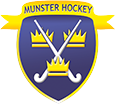Joan O’Reilly
O’Reilly, Joan Gertrude (1924–2014), hockey player, athlete and sports administrator, was born on 17 September 1924 in Dublin, one of six children (three daughters and three sons) of James O’Reilly, a butcher, and his wife Mary (née Hall). James, a prominent member of the Dublin Master Victuallers’ Association, traded from 33 Sundrive Road, Crumlin, Dublin, where the family also lived until they moved (c. 1942) to 125 Galtymore Road, Crumlin. Joan attended the private Loreto Junior School, 55 St Stephen’s Green, Dublin, before gaining her secondary education at Loreto College (1936–43), where she played hockey. In the final of the 1942 Leinster Senior Schoolgirls’ Hockey Cup, she captained the Loreto St Stephen’s Green side to victory and scored the only goal in extra-time.
A sporting all-rounder, she competed in the 100 yards and 200 yards sprints at athletics meetings in the Dublin region. She was joint winner of the GAA Dublin County Board Camogie Sports Championships, held at St James’s Park, Crumlin, in May 1939, which featured a range of sports including camogie and track and field events. She won the 100 yards race in 12.4 seconds. On 30 June 1940 she won the 100 yards race at the Civil Service Championships in 12.6 seconds, the best time in Ireland that year. She again claimed the best time on 26 June 1943, winning the 100 yards at the Kilkenny sports in 12.2 seconds. O’Reilly competed with the Crusaders Athletics Club short-lived ‘women’s section’ (c. 1947–51) and was good enough to have represented Ireland at the July 1948 Olympic Games in London. However, she was not considered for selection due to the prevailing widespread conservative opposition to women participating in ‘public’ sports such as track and field events. (Five women represented Ireland at the London Olympics, a fencer and four artists.) After the games, at an event in Belfast against the Australian Olympic team on 16 August 1948, O’Reilly placed second in the 100 yards behind Shirley Strickland, who had won bronze in London. On 26 August, at the Clonliffe Harriers Sports Meeting at Lansdowne Road, she placed third in the 100 yards, which was won by the renowned Dutch athlete Fanny Blankers-Koen (1918–2004) who had taken gold in London. When in July 1949 the newly formed Women’s Athletic Association of Ireland held events at Lansdowne Road, O’Reilly won both the 100 and 200 yards.
The opposition of the catholic hierarchy (especially John Charles McQuaid (qv)) to women competing in athletics led O’Reilly and many others of her generation to turn to team sports. From 1942 she played hockey for Old College (later renamed Old Alexandra) and from 1945 for Muckross Hockey Club. She established a place on the Muckross first XI in 1946, captaining the team from the mid-1950s, and featured regularly for Leinster in interprovincial competition from 1949. On 5 March 1949 she made her debut for Ireland in a 3–2 victory over Scotland in Belfast. She became a stalwart of the international team over the next decade, accumulating thirty-four caps, and featured in all three ‘home championship’ matches in 1950, including a 5–3 victory in Belfast over England (who had not lost to Ireland since 1908), as Ireland clinched the Triple Crown. On 19 April 1950 she scored in Ireland’s 4–0 victory over Belgium in Dublin, to close out Ireland’s most successful season up to that point. She was also a key figure for her club, which competed with Pembroke Wanderers Hockey Club for league and cup honours through the 1950s, and in 1954 she captained Muckross to the rarely achieved triple of Leinster Senior League, the Leinster Senior Cup and the Irish Senior Cup. She was at her best on the right wing, where her positional intelligence, blistering pace and adept crossing were most effective, but her skilful shooting and stick-work also allowed her to play centre-forward for Muckross, for whom she was a prolific scorer. Vera McWeeney (qv), the doyenne of Irish hockey journalism, recalled O’Reilly ‘bamboozling opposing defences with her astounding speed and setting up scoring chances for her inside forwards’ (Evening Herald, 15 Oct. 1959).
She revelled in international competition, which improved the national team’s cohesion and morale by bringing players together for prolonged periods, but like other Irish players had to pay her own costs. Featuring in international competitions in South Africa (1950), Folkestone (1953) and Amsterdam (1959), she captained the Irish team that toured the USA in October–November 1954 and won twenty-two of their twenty-four matches (the two games not won were drawn against the US national team).
Upon her retirement from playing for Muckross, Leinster and Ireland in 1959, O’Reilly turned to umpiring, gaining her ‘A’ badge in 1965, which enabled her to officiate at international fixtures. Instrumental in the formation of the Irish Umpire’s Association, she was closely involved in the general organisation and management of Irish hockey. She also coached Muckross for many years and from the 1960s onwards was a selector for Leinster and Ireland. In 1967 she managed the Irish teams which competed in the International Federation of Women’s Hockey Associations (IFWHA) tournament in Cologne, Germany, and did so again in the second IFWHA world championships in Vancouver, Canada (1979). She was frequently a delegate of the Irish Ladies’ Hockey Union at international fora and in the late 1970s chaired the Women’s Hockey Board of Great Britain and Ireland, which selected the joint Great Britain–Ireland Hockey team and organised the annual ‘home nations’ competition. She served as president of the Leinster branch (1973–8) of the Irish Ladies Hockey Union (ILHU) and was elected the union’s president (1977–8); she was awarded honorary life membership in 1986. A prominent figure in Irish hockey over four decades, she was regarded as one of the greatest hockey players of her generation and was an inaugural inductee into the Irish Hockey Hall of Fame in 2006.
Her devotion to hockey was complemented by a varied and busy social life. She revelled in the company of friends and enjoyed travel, playing bridge and golf. A keen member of the Grange Golf Club in Rathfarnham, she formed a formidable foursomes partnership with her Ireland teammate and close friend, goalkeeper Johnnie Lambert. In 1964 she was elected the club’s lady captain and inaugurated the lady captain’s show there. She regularly provided fine turkey and ham prizes for the club’s fundraising events and competitions. Modest and unassuming, she was widely respected.
She earned her living as a butcher, selling pig-meat from the family’s premises in Crumlin, while her brother James sold beef from the other end of the counter. Their sister Angela ran an adjacent drapery shop. Renowned as a leading business figure in the Crumlin area, she was a staunch supporter of the local community, was active in Crumlin Civil Defence and a board member of Donnybrook Hospital. She died on 10 January 2014 at the Belmont Nursing Home, Stillorgan, Co. Dublin, where she had lived for some time. After a funeral mass in Terenure College Chapel, she was buried in Bohernabreena Cemetery, Co. Dublin.
Credit: Dictionary of Irish Biography








